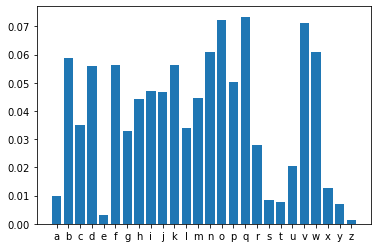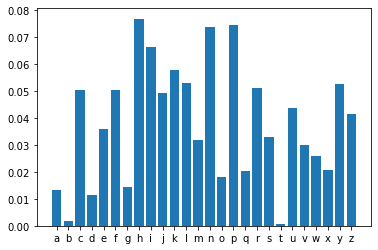【学习笔记】浅谈文本生成中的采样方法
本文学习记录一下,文本生成过程,以及过程中如何 选择/采样 下一个生成的词。首先将简单介绍一下文本生成(text generation)的完成过程;然后简单介绍下常用的采样(sampling)方法;最后,将实现并讨论以下三种采样方法(Greedy Sampling、Temperature Samling、Top-K采样)的优势和劣势。
什么是NLG ?
语言模型(LM, language model)用于生成文本,一般可分为word-by-word和character-by-character两种级别的方式。
训练过程中,我们利用一系列token序列(input, X)数据和目标token(targen, y)进行模型训练,期望得到一个能根据输入的序列,生成下一个token的条件概率分布(词汇表长度)的模型。下图案例表示在给定输入为"I want to cook"序列时,word-Level LM预测一个词汇表长度的条件概率分布的过程。

文本生成过程主要分为一下四个步骤:
- step1: 给定一个句子的序列作为
LM的输入 - step2:
LM输出一个词汇表长度的概率分布 - step3: 从概率分布中,依据某种策略,
sample一个词。 - step4: 将
sample到的词,拼接到生成文本的字符串 - step5: 继续输入下一个新序列,重复上述过程。

NLG解码策略
在文本生成任务中,sampling是指按照LM模型生成的所有token的条件概率分布,随机选择一个token。这意味着,在语言模型生成概率分布后,采取哪种策略来选择下一个token,显得极其重要。常见的策略有:
- Greedy Search (Maximization)
- Beam Search
- Temperature Sampling
- Top-K Sampling
- Top-P Sampling (Nucleus sampling)
本文将着重介绍前面三种方法及其实现,并在后面简单介绍其他两种方法的思想。
1.训练一个语言模型
本文着重关注的是采样(sampling)的方法及其实现,因此我们假设我们已经有了一个LM,该模型能够根据我们的输出,输出一个词汇表长度的概率分布。具体假设如下:
- 选择文本生成方式为 character-by-character.
- 词汇表(vocabulary)中的字符为'a' to 'z'.
- 已根据一定的预料,训练好语言模型( Language Model )
- 该
Language Model能够根据输入序列生成一个词汇表长度的条件概率分布。 - 现在,我们需要的是根据概率分布,sample
(select)下一个 token。
1.1 定义词典
dictionary =[]
for c in range(ord('a'), ord('z')+1):
dictionary.append(chr(c))
1.2 模拟一个已训练好的LM
class language_model:
def __init__(self, dictionary):
self.dictionary = dictionary
def predict(self):
output= np.random.rand(len(dictionary))
output=output/output.sum()
return output
# model=language_model(dictionary)
1.3 模拟生成的条件概率分布
predictions= model.predict()
plt.bar(dictionary,predictions)
plt.show()
经过上述假设,我们可以开始下面的采样策略的实现了。
常见采样策略
Greedy Search解码
Greedy search方法的思想较为简单,就是直接选择概率分布中概率最大的token((或字符))作为当前解码出来的词(或字符)。 但是,该方法的问题在于,如果我们总是选择概率最大的词,将会生成很多重复的句子( get stuck in loops ),例如“I don’t know. I don’t know. I don’t know. I don’t know.”样例代码如下:
def greedy_search(conditional_probability):
# print(np.argmax(conditional_probability))
return (np.argmax(conditional_probability))
print(predictions)
next_token = greedy_search(predictions)
print(next_token)
print("Sampled token: ",dictionary[next_token])
输出:
[0.01558192 0.00141205 0.05824388 0.05974056 0.07144658 0.02249477
0.03664056 0.07573829 0.0782964 0.07217844 0.01622408 0.02825687
0.02290704 0.04392459 0.04238757 0.03190642 0.00968754 0.02540264
0.00605495 0.02393471 0.03006855 0.00061328 0.07406862 0.06144887
0.06505202 0.02628881]
8
Sampled token: i
Beam Search 解码
另一种比较流行的解码方法叫beam search,该方法是对greedy search的扩展版本,返回一系列最有可能的输出序列。
和greedy search选择可能性最大的构成序列不同,beam search在\(t\)步时,生成$t + 1$步的所有可能组成,并从中选择k个概率最大的组合,其中k为指定的搜索参数。
我们在开始的位置不用随机选择,而是选择K个最可能在开始位置的词语作为序列的第一个词。
当K取1时,即为Greedy Search,而在大多数机器翻译的任务中 K一般取值5-10。当K较大时,往往会带来较好的结果,因为保留更多的选择性,更可能带来最佳的组合,相应的,也会增加计算成本和解码速度。
举例说明上述表述。首先,定义一个函数,该函数在给定一个序列(假设长度为N, 词汇表长度为V)的概率分布(矩阵,N x V),以及搜索参数K时,得到解码结果。在每一个step,每一个候选子序列( candidate sequence)扩展所有可能的下一个子token,然后按照score进行排序,并选择score最大的K个子序列,作为当前step的解码结果。重复上述过程,直到迭代结束。
一般来说,概率值时较小的数值,经过一些列连乘后,会更小,为防止下溢(underflowing the floating point numbers),将其计算转换为取其对数,然后相加的过程。样例代码如下:
from math import log
from numpy import array
from numpy import argmax
def beam_search_decoder(data, k):
sequences = [[list(), 0.0]]
# 迭代序列中的每一步
for row in data:
all_candidates = list()
# 计算每种 hypotheses 的分值,并存储到 all_candidates
for i in range(len(sequences)):
seq, score = sequences[i]
for j in range(len(row)):
candidate = [seq + [j], score - log(row[j])]
# print("da, ", candidate)
all_candidates.append(candidate)
print(f"j={j},all_cand={all_candidates}")
# 对所有的候选序列,通过 score 排序
ordered = sorted(all_candidates, key=lambda tup:tup[1])
# 选择 K 个分 score 最高的
sequences = ordered[:k]
return sequences
结果如下:
n = 10
data = []
for i in range(10):
prediction = model.predict()
data.append(prediction)
data = array(data)
# print(data)
result = beam_search_decoder(data, 5)
for seq in result:
print(seq)
TEMPERATURE 采样
Temperature sampling 的想法源于热力统计学的概念,温度高往往意味着更容易是低能量状态。在概率模型中, logits 代表能量值,将其送入softmax函数钱,除以temperature值,得到最终的采样概率分布。 一个Temperature Sampling的keras实现案例。
0. 绘制模型生成的条件概率分布
plt.bar(dictionary,predictions)
plt.show()
1. 使用 “temperature” Reweighting 分布
temperature=0.2
conditional_probability = np.asarray(predictions).astype("float64")
conditional_probability = np.log(conditional_probability) / temperature
plt.bar(dictionary,conditional_probability)
plt.show()
2. 应用 softmax 函数
softmax函数的原理是将集合中每个元素转化成对应的指数形式,然后分别处理所有元素指数的和,公式如下:
def softmax(z):
return np.exp(z)/sum(np.exp(z))
reweighted_conditional_probability = softmax(conditional_probability)
plt.bar(dictionary,reweighted_conditional_probability)
plt.show()
3. 从 reweighted 的分布中,重新采样下一个字母
我们采用多项式分布( **multinomial distribution**)从中sample一个token。多项式分布函数中的 参数有:
-
n: int, Number of experiments.
-
pvals: sequence of floats, length p. Probabilities of each of the p different outcomes. These must sum to 1 (however, the last element is always assumed to account for the remaining probability, as long as sum(pvals[:-1]) <= 1).
-
size: int or tuple of ints, optional. Output shape. If the given shape is, e.g., (m, n, k), then m * n * k samples are drawn. Default is None, in which case a single value is returned.
我们调用多项式分布函数,并设置参数为(1, reweighted_conditional_probability, 1) ,因为我们只需要实验一次,并从概率分布中sample出一个结果。 样例代码如下:
probas = np.random.multinomial(1, reweighted_conditional_probability, 1)
plt.bar(dictionary,np.squeeze(probas))
plt.show()
4 把之前的操作放在一起
def temperature_sampling (conditional_probability, temperature=1.0):
conditional_probability = np.asarray(conditional_probability).astype("float64")
conditional_probability = np.log(conditional_probability) / temperature
reweighted_conditional_probability = softmax(conditional_probability)
probas = np.random.multinomial(1, reweighted_conditional_probability, 1)
plt.bar(dictionary,reweighted_conditional_probability)
plt.show()
return np.argmax(probas)
for temp in np.arange(0.2,1.6,0.8):
next_token = temperature_sampling(predictions, temperature=temp)
print("Temperature: ", temp)
print("Sampled token: ",dictionary[next_token],"\n")
5. 一些观察后的结论
在大多数研究中, tempreature的选择,往往呈现如下规律:
-
当 temperature 设置为较小或者0的值时,
Temperature Sampling等同于 每次选择最大概率的 Greedy Search。 -
小的temperature 会引发极大的 repetitive 和predictable文本,但是文本内容往往更贴合语料(
highlyrealistic),基本所有的词都来自与语料库。 -
当temperatures较大时, 生成的文本更具有随机性( random)、趣味性( interesting),甚至创造性( creative); 甚至有些时候能发现一些新词(misspelled words) 。
-
当 设置高 temperature时,文本局部结构往往会被破坏,大多数词可能会时semi-random strings 的形式。
-
实际应用中,往往experiment with multiple temperature values! 当保持了一定的随机性又能不破坏结构时,往往会得到有意思的生成文本。
Top K 采样
原文链接(Fan et. al, 2018) 该论文介绍了一种新的简单但是高效的采样方法,Top-K sampling。
在Top-K 采样中, 依旧是从概率分布中,依据概率最大选择k个单词中,不同的点在于,该方法会对这K个词的概率重新再次进行分布(redistributed),然后依据新的概率分布重新取下一个token。GPT2模型就是用的这种采样方法,使其在故事生成(story generation)方面较为成熟。具体如下
1.首先我们有一个概率分布
predictions= model.predict()
plt.bar(dictionary,predictions)
plt.show()
2.选择top K分布
我们使用函数tf.math.top_k() 在概率分布中输出 最大的 k 个 实体的值(values)及其对应的索引(indices )。通过索引,我们能得到其对应的tokens.
k=5
top_k_probabilities, top_k_indices= tf.math.top_k(predictions, k=k, sorted=True)
top_k_indices = np.asarray(top_k_indices).astype("int32")
top_k_tokens=[dictionary[i] for i in top_k_indices]
top_k_indices, top_k_tokens
# top_k_probabilities.numpy().sum()
(array([ 8, 7, 22, 9, 4]), ['i', 'h', 'w', 'j', 'e'])
3. 应用softmax函数
top_k_redistributed_probability=softmax(np.log(top_k_probabilities))
top_k_redistributed_probability = np.asarray(top_k_redistributed_probability).astype("float32")
print('top_k_tokens: ',top_k_tokens)
print('top_k_redistributed_probability: ',top_k_redistributed_probability)
print('Total probability: ', top_k_redistributed_probability.sum())
top_k_tokens: ['h', 'p', 'n', 'i', 'k']
top_k_redistributed_probability: [0.21983118 0.21332353 0.21130912 0.19023508 0.16530107]
Total probability: 1.0
plt.bar(top_k_tokens,top_k_redistributed_probability)
plt.show()
4.从 reweighted 的分布中,重新采样下一个字母
sampled_token = np.random.choice(top_k_indices,
p=top_k_redistributed_probability)
print("Sampled token id: ",sampled_token,
" token: ",dictionary[sampled_token])
Sampled token id: 11 token: l
5. 完整过程
def top_k_sampling(conditional_probability, k):
top_k_probabilities, top_k_indices= tf.math.top_k(predictions, k=k, sorted=True)
top_k_indices = np.asarray(top_k_indices).astype("int32")
top_k_redistributed_probability=softmax(np.log(top_k_probabilities))
top_k_redistributed_probability = np.asarray(top_k_redistributed_probability).astype("float32")
sampled_token = np.random.choice(top_k_indices, p=top_k_redistributed_probability)
top_k_tokens=[dictionary[i] for i in top_k_indices]
plt.bar(top_k_tokens,top_k_redistributed_probability)
plt.show()
return sampled_token
predictions= model.predict()
plt.bar(dictionary,predictions)
plt.show()
6.使用 top-k 采样 different k values
for k in range (5, 25, 5):
next_token = top_k_sampling(predictions, k=k)
print("k: ", k)
print("Sampled token: ",dictionary[next_token],"\n")
7. 一些观察后的结论
基本top k的采样方法,能够提升生成质量,因为它会把概率较低的结果丢弃( removing the tail),因此能使得生成过程不那么偏离主题。
但是一些情况下:
-
丢弃掉的部分(Tail)可能会包含很多的词语,这导致我们能选择的词汇较少。
-
而在一些情况下,丢弃掉大部分可能包含的词汇较少,我们能生成较为丰富的文本。
因此, k 值的选择对于生成结果极其重要。
Top p采样
有很多采样的方法被提出来,top p也是其中一种最为常见的方法。
- Top-P Sampling (Nucleus sampling): 与
top k对低概率词汇直接丢弃的处理方法不同,top p采用的是累计概率的方式。即从累计概率超过某一个阈值p的词汇中进行采样。换言之,根据参数p的大小调节(0<=p<=1),Top-P Sampling增大了出现概率较小的词汇的生成的概率。 更多细节说明样例代码:
def scatter_values_on_batch_indices(values, batch_indices):
shape = shape_list(batch_indices)
# broadcast batch dim to shape
broad_casted_batch_dims = tf.reshape(tf.broadcast_to(tf.expand_dims(tf.range(shape[0]), axis=-1), shape), [1, -1])
# transform batch_indices to pair_indices
pair_indices = tf.transpose(tf.concat([broad_casted_batch_dims, tf.reshape(batch_indices, [1, -1])], 0))
# scatter values to pair indices
return tf.scatter_nd(pair_indices, tf.reshape(values, [-1]), shape)
def set_tensor_by_indices_to_value(tensor, indices, value):
# create value_tensor since tensor value assignment is not possible in TF
value_tensor = tf.zeros_like(tensor) + value
return tf.where(indices, value_tensor, tensor)
def shape_list(x):
"""Deal with dynamic shape in tensorflow cleanly."""
static = x.shape.as_list()
dynamic = tf.shape(x)
return [dynamic[i] if s is None else s for i, s in enumerate(static)]
def top_p_decoding(logits, top_p=1.0, filter_value=-float("Inf"), min_tokens_to_keep=1):
sorted_indices = tf.argsort(logits, direction="DESCENDING")
sorted_logits = tf.gather(
logits, sorted_indices, axis=-1, batch_dims=1
) # expects logits to be of dim (batch_size, vocab_size)
cumulative_probs = tf.math.cumsum(tf.nn.softmax(sorted_logits, axis=-1), axis=-1)
# Remove tokens with cumulative probability above the threshold (token with 0 are kept)
sorted_indices_to_remove = cumulative_probs > top_p
if min_tokens_to_keep > 1:
# Keep at least min_tokens_to_keep (set to min_tokens_to_keep-1 because we add the first one below)
sorted_indices_to_remove = tf.concat(
[
tf.zeros_like(sorted_indices_to_remove[:, :min_tokens_to_keep]),
sorted_indices_to_remove[:, min_tokens_to_keep:],
],
-1,
)
# Shift the indices to the right to keep also the first token above the threshold
sorted_indices_to_remove = tf.roll(sorted_indices_to_remove, 1, axis=-1)
sorted_indices_to_remove = tf.concat(
[tf.zeros_like(sorted_indices_to_remove[:, :1]), sorted_indices_to_remove[:, 1:]],
-1,
)
# scatter sorted tensors to original indexing
indices_to_remove = scatter_values_on_batch_indices(sorted_indices_to_remove, sorted_indices)
logits = set_tensor_by_indices_to_value(logits, indices_to_remove, filter_value)
return logits
n = 10
data = []
for i in range(10):
prediction = model.predict()
data.append(prediction)
data = array(data)
print(data)
result = top_p_decoding(data, 0.5)
for seq in result:
print(seq)
总结
本文讨论了文本生成过程中的一些常见的采样方法及其部分实现。也讨论了不同方法间的优缺点。总体而言,没有最好的方法,只有最适合任务的方法,推荐结合具体任务通过反复实验找到最佳的生成方法。推荐使用不同的参数,在生成文本的结构性和随机性之间进行权衡,来得到有意思的文本生成结果。











 浙公网安备 33010602011771号
浙公网安备 33010602011771号